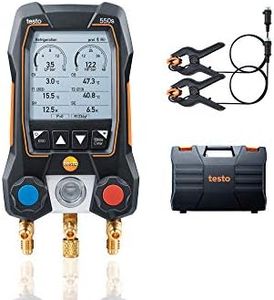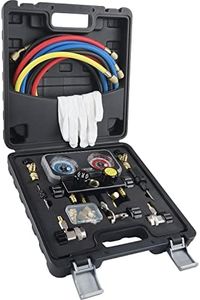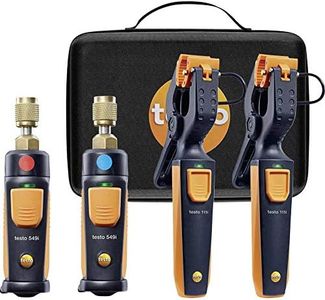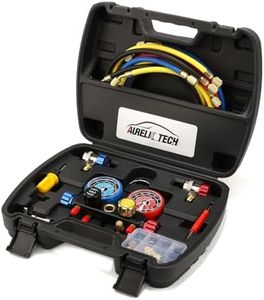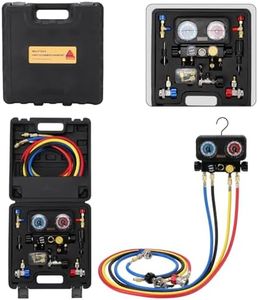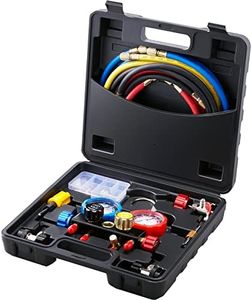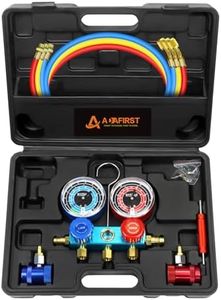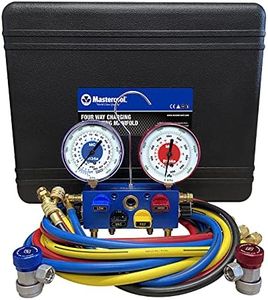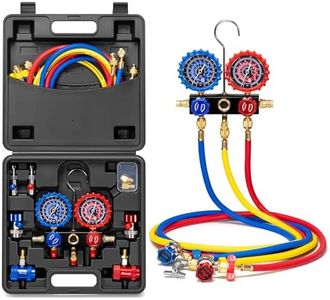We Use CookiesWe use cookies to enhance the security, performance,
functionality and for analytical and promotional activities. By continuing to browse this site you
are agreeing to our privacy policy
10 Best Air Conditioning Gauges
From leading brands and best sellers available on the web.Buying Guide for the Best Air Conditioning Gauges
When choosing air conditioning gauges, the goal is to help you maintain, charge, or diagnose issues in your AC system easily and accurately. These tools measure the pressure of refrigerant, which is vital for both professional HVAC technicians and DIY enthusiasts working on automotive or home air conditioning systems. To select the right set of gauges, it's important to pay attention to key features that match your needs and ensure reliable and safe operation.Gauge Type (Analog vs. Digital)The type of gauge refers to how the pressure readings are displayed: analog gauges use a dial with a needle, while digital gauges have an electronic screen. Analog gauges are often more affordable, straightforward, and don’t require batteries, but they can be harder to read precisely. Digital gauges are easier to read, often more accurate, and may include extra features like temperature calculation, but they rely on batteries or a power source. If you're new to AC work or want quick, easy readings, digital can be great. Choose analog if you prefer simplicity and reliability.
Manifold Design (Number of Valves)The manifold design relates to how many service ports and valves the gauge set has, most commonly two-valve and three-valve sets. Two-valve manifolds work well for simple recharging and checking pressure, while three-valve sets allow for more advanced functions like evacuating (removing air and moisture) while still monitoring high and low pressures. For basic maintenance, a two-valve is generally enough, but for deeper diagnostics or advanced tasks, a three-valve design is typically preferred.
Compatibility with Refrigerant TypeAir-conditioning systems use different types of refrigerant, such as R-134a, R-410A, or R-22, and gauges must be compatible with the specific refrigerant in your system. Using the wrong gauge can give inaccurate readings or damage the system. Most gauges are marked for certain refrigerants. Always check which refrigerant your AC uses and make sure the gauge set is designed for it. If you work with more than one AC type, look for universal or multi-refrigerant gauges.
Hose Quality and LengthThe hoses connect your gauges to the AC system. Length and quality are both important: shorter hoses (around 3 feet) are easier to handle and carry, while longer hoses (up to 5 feet or more) offer more flexibility for reaching awkward places. Hose material should be durable and rated for the appropriate pressures. If you're working in tight spots, shorter hoses may be easier to manage; for home units or harder-to-reach areas, longer hoses could be necessary.
Accuracy and CalibrationGauge accuracy determines how closely the reading matches the real pressure. Higher accuracy gauges are crucial for proper system care, especially when working on systems with small tolerances. Many gauges mention their level of accuracy or feature calibrations to help guarantee correct readings. If you need to ensure top performance or are servicing sensitive systems, prioritize accuracy; for basic tasks, slightly lower accuracy may be acceptable but should still be sufficient for safety and reliability.
Durability and Build QualityDurability refers to how well the gauges and manifold can withstand general wear, drops, and rough use. Look for sets with metal (usually brass or aluminum) manifolds, reinforced hoses, and protective covers on the gauges. A robust build means your set will last longer and remain accurate. If you'll use these gauges regularly or in demanding environments, sturdier models are worthwhile; for occasional home or personal car use, moderate build quality may suffice.

